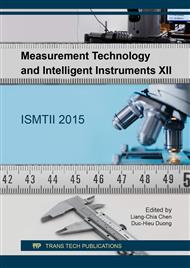p.357
p.363
p.369
p.375
p.383
p.389
p.395
p.401
p.407
Investigate the Humping Ferro-Damp Induced under Non-Uniform Magnetic Field Density
Abstract:
Under non-uniform magnetic field distribution, the humping ferro-damp used to reduce the oscillation of ferro-wave is investigated. Through experimental observation and analytic analysis, the dynamical stability at the so called “humping pool”, enclosed by both centers of permanent magnetisms, is found to be closely dependent on the oscillating frequency, field intensity & the separated distance of magnetisms. Though nodal shift of pool 0.07~0.11 cm, recorded from video-camera suited on self-designed oscillating system, begins to occur as in the deployment of higher ferro-level or lower field strength 0~ 30 mT, however such the stable response of humping pool, without remarkable change of vibrating amplitude 0.03 ~0.06 cm, might be under control while oscillating frequency of 0.5~2 Hz is subjected. That could be attributed to the concentrated ferro-viscosity as well as the strongest ferro-magnetization, induced at the humps, initiates a recovering constrain for oscillating pool. Unlike above humping damp accessed, an irregular and random ferro-profile will be generated outside pool region. Such humping deployment, as a manner of shockproof, might be utilized to reduce the seismic damage and that makes damping analysis of seismic study become more practical and approach to the intended demand.
Info:
Periodical:
Pages:
383-388
Citation:
Online since:
September 2017
Authors:
Keywords:
Price:
Сopyright:
© 2017 Trans Tech Publications Ltd. All Rights Reserved
Share:
Citation:


